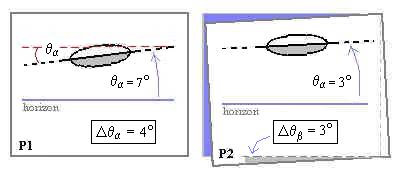
The Trindade Island Photographs, 16 Jan 1958
A
study of the image-inversion hoax hypothesis
(Feb 2004.
Last update 16 Mar 2004)
(index) Part Two (<Back to Part 1)
In Part One we have seen that P1 and P2 are indeed similar under rotation, but that they also differ in gross outline, in the distribution of dark and light areas, and in the angle of a blur-like internal striation that appears to be unique to each of the P1 and P2 images. On the face of it these different internal "fingerprints" appear to argue against the hypothesis that P2 is produced from P1 by a simple inversion. However, although we have shown that the striae are independent of the axes of internal symmetry of the images, it remains to be shown that they are independent of the images' optical, chemical and digital histories. Possible sources of differential distortion that might in principle affect the result are the camera optics, the film emulsion, the scanning raster and chemical/mechanical variables in processing.
camera optics
First we need to establish the difference in orientation relative to the film/camera system, which is the sum of two differences: a, the angle between the orientations of the P1 and P2 objects relative to the horizon, and b, the angle of rotation of the frame of the picture between P1 and P2. Both differences as measured from the prints turn out to have the same sign and add to about 7° in the direction of reducing the difference in the obliquity of the striae (Fig.11). But about six times this rotation would be necessary to reduce the difference in the obliquity of the striae to zero.
The value of b cannot be known directly without the negatives of course. It is reasonable to ask if cropping of the print area might conceal a large value of b. But there are good reasons to conclude that the picture edges in the most complete prints are approximately parallel with the true edge of the negative area.

Fig.11.
The difference in image orientation relative to the camera system
Dq s = Dq a + Dq b = 7°
Cropping might normally be done to isolate the subject of interest and/or to level-up either the subject or the surroundings for the sake of uniformity. Brad Sparks has pointed out (personal communication) that in this case there is no uniformity in the orientations of the subject or of the horizons in relation to the print edges, which one would expect if the prints are cropped. Moreover the subject (UFO) is certainly not selected: its image is tiny, only about 1/30 of the linear print dimensions or ~ 1/1000 of the area. To account for the angle in Fig.9 we would need the supposedly incomplete prints to be cropped by 25% or more on each dimension. This would mean that the print areas correspond to a FOV of <30°, not ~ 40°, and the resolution of shadow-detail on the negative scale - already a problem for a hoax that requires multiple-generation copying - would then be >25% better than it appears. (It is also not clear that an increase in the ship-to-shore distance by a factor of at least 1.5, implied by the reduced angular scale of the island topography, could remain consistent with the ship's position suggested by triangulation.)
There is no realistic possibility that the cropping of any set of prints could be so large as to conceal a mismatch between print and negative orientations of more than a few degrees. This is an order of magnitude smaller than required.
So it is reasonable to judge that the situation in Fig.11 is approximately correct, Dqs is small and the orientation of the striae in P1 and P2 does differ significantly not only with respect to the internal axes of symmetry of the UFO images but also in relation to the camera system. This argues that the striae are not an artefact of the camera optics, a conclusion supported by the fact that the orientation of the striae has no systemmatic relationship to the optical axis. Moreover, the images occupy different positions in the visual field and therefore would have a different optical history, yet are in each case the only objects in the field that are affected (see below).
emulsion defects
Similar considerations apply to the film structure. A chemical or mechanical anisotropy in the way the emulsion is deposited on the substrate might cause streakiness, but we would not expect such a flaw to change its angle within a distance of a few centimetres on the same film roll - also there appears to be no evidence of such a flaw elsewhere on the prints, although there is a great deal of fine detail that would be within a centimetre or two of each image on the negatives.
The rock detail enlarged in Fig.12 shows no anisotropy whatever on the scale of the UFO images, or on any scale down to the limit of resolution, which is probably better than about 5% of the scale of the vertical striations in the UFO images. (These crude image files, prepared from JPEGs made from a digital scan of an optically enlarged paper print, probably resolve better than 25 lpmm on the negative scale, which gives some idea of the likely original resolution. In fact resolution as good as 85 lpmm has been reported in studio tests of a 1956 Rollei 2.8E, comparable with the very best modern lens systems.)
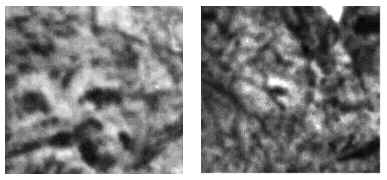
Fig.12 Contrast-enhanced details from mountains below UFO image on P2. Each area is about 2° wide, about 25% wider than the UFO image itself, and would represent a roughly 3 mm square on the negative. Fine shadow structure is probably resolved here down to about 0.04mm (40 micrometres) or less on the negative scale. There is no evidence of any anisotropic flaws in the emulsion.
scanning raster
The same objection argues against the striations being an artefact of the scanning raster. The scan orientation on both images might conceivably be different on the two prints, but again the flaw would have to be restricted in each case to the region of the UFO image, which seems highly implausible - even if the striation had the appearance of a digital artefact, which it does not.
film processing
Streakiness is a conceivable consequence of the development process. The known use of out-of-date chemicals on the ship could be a factor. Possibly the strenuous agitation of the developing dish along with the use of cold developer in order to force contrast might cause something like this effect, either at the negative stage or at the print stage. (The average noon-time temperature during Trindade's tropical summer would actually be higher than the optimum development temperature, so achieving 'cold' chemicals at the neg stage when working with makeshift equipment in a disused lavatory in the bowels of the ship might not be easy.) The same points apply to the process of reduction (using potassium ferricyanide to reduce away the developed silver to compensate for a slight overexposure) which is said to have been applied later, ashore, to two of the negatives.
However, again one cannot understand why in normal usage such an anomaly would selectively target only the UFO image in each case without leaving a trace on the rest of the negative or print area. This localisation implies a very selective treatment of the area of the UFO image.
One common trick for bringing out a small area of fugitive low density on an enlarged positive print is to 'rub up' the area with a warm finger during the development. This locally heats and accelerates the chemical reaction. (To directly cause the observed effect by violent rubbing one would probably have to cause visible mechanical damage to the soft surface of the print emulsion.) But this in itself would bring out the UFO image as a whole and could only serve to darken a streakiness that was already there, so is not an explanation. Also rubbing up a print image only some 6mm across would be expected to darken the immediately surrounding area of cloud detail as well, and a similar objection applies to localised chemical treatments. No anomalous dark (or light) halo around the UFO is visible to the eye, nor is it evident in photometric study of print densities (Brad Sparks, personal communication; there are blemishes consistent with finger marks elsewhere on some prints but not in the area of the UFO). Finally, of course, there are several different sets of first-generation prints. Barauna reportedly made 38 sets for the Navy in January 1958 and an unknown number for private and commercial distribution. I am aware of 3 complete or nearly complete sets, plus1 heavily cropped set, in the hands of researchers today. No localised difference in the UFO images from print to print has to my knowledge been reported to exist, but this could be verified by direct examination.
So a number of lines of argument tend to show:
that the linear structure we have identified inside the scanned images exists on the negatives,
that differences in structure between P1 and P2 probably cannot be explained by any likely flaw in the camera optics or film emulsion,
that these differences in structure cannot be explained by inversion or any other simple transformation of one image into the other,
and that the differences are therefore most likely due to statical properties of two different image sources, or to dynamical properties of one common image source.
the status of the image-inversion hoax hypothesis
We have seen that P1 and P2 are indeed similar under rotation, but that they also differ in gross outline, in the distribution of dark and light areas, and in the angle of a blur-like internal striation which appears to be independent not only of the axes of internal symmetry of the images but also of their optical, chemical and digital history. If we wish to maintain that the apparent similarity of P1 and P2 under rotation is symptomatic of a darkroom inversion, we have to assume that this is because both images were made from some third original source, and were differently and separately transformed in various ways before being inverted and superimposed onto the island backgrounds.
We seem to have reached a point where much of the force of the original photo-inversion hypothesis, with its merit of natural simplicity, has been dissipated in ad hoc adaptation to new facts. Certainly the idea of a darkroom hoax does not look more attractive now than when we began, and arguably it looks less so - although nothing said here so far rules out (of itself) the various kinds of double-exposure and photomontage that have been considered as possible hoax methods.
A detailed discussion of the technical difficulties of double-exposure and montage theories is beyond the scope of this page. Suffice to say that the original Brazilian Navy intelligence evaluation based on microscopic examination of the negatives in 1958 remains uncontradicted by digital photometric analysis of first-generation prints as of 2004: a hoax involving double-exposure "would be of extreme technical difficulty and would also require favourable circumstances for its execution". It may be possible to go further than this statement - detailed work on these issues by other investigators is underway at the present time (Brad Sparks, personal communications). The upshot is that the pictures would be much easier to explain if there was a 'real object' of some sort photographed from the deck of the Almirante Saldanha at the time and place stated (there is strong internal evidence that the islandscapes were photographed at the time claimed on the date in question), and one wonders therefore whether the image properties we have found could be consistent with a single-exposure hoax staged in real time.
a single-exposure hoax in real time?
One interesting possibility is suggested by the 'Barasub'. The Barasub was a glass-fronted waterproof camera case for underwater photography developed by Barauna himself and which became something of a commercial success. Barauna is pictured with this invention in the newspaper Ultima Hora, 21 Feb 1958, next to the story of the UFO sighting. An image on a glass plate an inch or two from the lens could not possibly be in focus for any realistic f/stop. But is it possible that working on the Barasub could have given Barauna the idea for a hoax method?
Suppose that a glass plate or positive acetate carrying a "UFO" image were held a few feet in front of the camera whilst Barauna photographed the island - might this explain how an image gets flipped upside down or back to front in haste? Might blurring due to movement of this plate cause the differing streakiness we have found in the P1 and P2 images? Changing the angle of the glass plate in relation to the film plane would change the axial ratio of the UFO. Could this also give support to claims made by Mori, Borraz, Noguez and others that all four of the UFO photographs are differently stretched or compressed and resized versions of a single fake image?
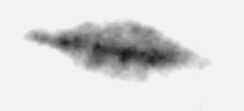
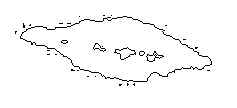
Fig.13. P4 at high contrast, and digital tracing of two density contours to isolate equatorial structure
If we look at P4, we see some sign of vertical striation in the lower part of the image, and just the suggestion of what might be a "dark spot" on the upper part, but most noteable is the way that in P4 the striation develops from what appear to be discrete dark nodules along the edge of the equatorial 'flange'.
In P3, the largest and apparently the sharpest of the images, this structure becomes quite well defined. This nodular flange detail is brought out clearly in Fig.14 below (despite the poor resolution of this image).
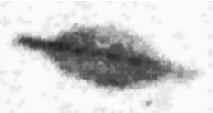
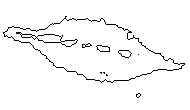
Fig.14. P3 and digital tracing of two density contours to isolate equatorial structure
So our hypothesis might be that all the images are distorted versions of P3, seen at different distances from the lens and with some added motion blurring. We can put some rough numbers to this for illustration. If the glass plate is held 24" from the lens and photographed at 1/125 sec. as reported then the characteristic motion normal to the optical axis needed to blur the dark nodules of P3 into striae of the length seen in P2 would be around 5"/sec., which is not an unreasonable rate of tremor for a glass plate (say) held unsteadily at arm's length.
However the angular subtense of P4 is almost three times as small as P3, implying that the plate would have to have been moved to three times the distance. The plate could be held near the rail while the camera moves back from the rail; but the rail is captured clearly in P3 and P4 and obviously is not 3 times as far away - its angular scale and poorer focus in fact confirm the rail to be closer in P4 than in P3. (It should be noted that twin reflex cameras like the Rolleiflex 2.8E did not have interchangeable or zoom lenses.) The angular size of the UFO image would be slightly larger in P4, not three times smaller, unless the glass plate has moved almost three times further from the camera whilst the camera itself remains near the deck rail.
The FOV of the 80mm lens fixes the maximum distance from the lens to the ~1.3" top rail (see here) as about 24" (21" - 24" for print FOV 35°- 40°), so there are severe upper and lower constraints on the possible distance from lens to glass plate, imposed by geometrical optics and depth of field respectively, which combine to require that the P3 glass plate would have to move out a considerable distance over the sea to produce the image in P4.
For the island background and the UFO image to be both acceptably in focus the minimum near-field distance for the UFO even at f/64 (Barauna originally stated his setting was f/8) would be nearly four feet, as can be seen from Table 1 below. The practical definition of focus in this case will be the resolution of the UFO relative to the best-resolved static subject at effective infinity, i.e. the island.
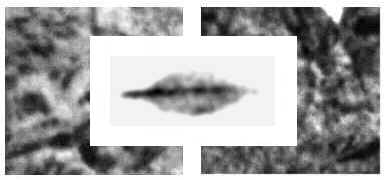
Fig.15. P3 shown against island background, both at approximately the same scale and contrast enhanced
We saw in Fig.12 that the resolution of the island in our scans is probably equivalent to 25 lpmm or better on the negative scale. This implies that if the UFO is in comparable focus we should be able to resolve details down to about 1/50 of its own width (if they exist). This is comparable to the pixel scale on the JPEG in Fig.14 and is something over a millimetre on the scale of the P3 image in Fig.15, which is about 60mm across on my screen. This is a subjective and unsatisfactory business, but I judge that the UFO image is in reasonably sharp focus in terms of this definition.
focus distance from lens in feet |
||||||||
2 |
4 |
8 |
16 |
32 |
64 |
128 |
||
depth of field in feet |
||||||||
4 |
1.96-2.04 |
3.86-4.15 |
7.46-8.62 |
13.68-18.68 |
24.87-44.85 |
40.7-109.21 |
59.65-inf. |
|
5.6 |
1.95-2.05 |
3.81-4.21 |
7.27-8.89 |
13.33-20.01 |
23.56-49.86 |
35.5-323.6 |
49.15-inf. |
|
8 |
1.93-2.07 |
3.73-4.31 |
7.00-9.34 |
12.44-22.47 |
20.34-74.95 |
29.82-inf. |
38.88-inf. |
|
11 |
1.90-2.10 |
3.64-4.44 |
6.68-9.96 |
11.48-26.40 |
17.9-150.88 |
24.85-inf. |
30.83-inf. |
|
16 |
1.87-2.15 |
3.50-4.67 |
6.22-11.21 |
10.17-37.47 |
14.91-inf. |
19.44-inf. |
22.92-inf. |
|
22 |
1.82-2.22 |
3.34-4.98 |
5.73-13.20 |
8.95-75.44 |
12.42-inf. |
15.42-inf. |
17.53-inf. |
|
32 |
1.75-2.33 |
3.11-5.61 |
5.09-18.74 |
7.46-inf. |
9.72-inf. |
11.46-inf. |
12.59-inf. | |
64 |
1.55-2.80 |
2.54-9.37 |
3.73-inf. |
4.86-inf. |
5.73-inf. |
6.29-inf. |
6.62-inf. |
|
Table 1. Depth of field table, 80mm FL, 6x6 format. (The distances should be regarded as a guide because in practice there is no such thing as perfect focus, and the definition of acceptable focus depends on extraneous variables.)
Even if we allow that P3 is not in perfect focus it is clear, allowing for a degree of degradation due to motion-blurring (and note that stopping down from f/8 to f/64 cuts available light by 1:1/32, requiring a longer shutter time that tends to increase motion-blurring) that it must be almost in focus. The image is thus at least a large fraction of the smallest possible near-field distance from the lens in P3 - i.e., feet rather than inches. Since the vertical stanchion in P3 is probably over 6' from the lens (see here) we can accept that an image on a glass plate is physically possible in this case. But in the case of P4 the angular diminution of the image implies that the glass plate must be suspended some 10' beyond the now-nearer deck rail. This introduces obvious practical difficulties.
near depth (feet) |
focal distance (feet) |
f/stop |
0.5 |
1 |
446 |
1 |
2 |
223 |
2 |
4 |
112 |
4 |
7.99 |
56 |
Table 2. Some f/stop values for very small near-field distances.
If you stop a lens down far enough, of course, then the near edge of the depth of field approaches zero. In principle Barauna could adapt his camera to any arbitrarily small aperture, bringing the datum distance of the glass plate arbitrarily close. Table 2 shows that an aperture of around f/300 would allow the glass plate to be in focus at less than a foot from the lens to produce P3, with the distance for P4 remaining within arm's length. But stopping down to this extreme would cut the light down by a factor of the order 100 from the more usual values in the top half of Table 1, and the characteristic exposure time would now be seconds instead of hundredths of a second, making sharp island detail virtually impossible to achieve from a ship in a choppy sea.
Aside from this, notice the internal evidence of the photos that the aperture was not stopped down in order to bring the near-field distance within range for a glass-plate image: None of the foreground structures - from the rail at less than 2' in P4 to the vertical stanchion in P3 at more than 6' distance - is in focus.
From examination of the rails in P3 it would be reasonable to say that the near-field distance of the lens cannot be closer than 10' and is probably greater, whilst the detail of the sea surface behind the out-of-focus rail in P4 appears to be in good focus. Assuming a camera height of 4' above the deck, a rail ~ 2' distant from the lens at a height of 45" above the deck, and a deck 23' above the sea (see here), this sea surface is ~170' slant range from the lens. This is a gross approximation of course; but the result that the near-field distance lies between about the two orders of magnitude 10 and 100 feet is probably reliable, and this is certainly not inconsistent with Barauna's claim of f/8, which from Table 1 we would expect to give a depth of field from about 30' to infinity. It is however grossly inconsistent with any in-focus image of a fake UFO photographed at short range comparable with the distance to the deck rail: the angular scale of resolved detail in any of the UFO images is smaller than the angular blurring of the edges of any of the rail images.
Even discounting these arguments, the effect on the changing focus of the image from P3 to P4 should be the opposite to what we see. Moving the plate three times further away as in P4 would improve the imperfect focus of the UFO image, and equivalent physical movements would become angularly smaller and so less significant, leading to a sharper image with less motion blur, all of which ought to more than compensate the reduced scale. Similarly P1 and P2 are smaller images than P3 and so represent the original UFO image at a greater distance; they should both be improving in focus. Yet the resolutions of P1 and P2 are worse, and that of P4 markedly worse, than P3.
If the glass plate is stationary for P3 but not for P1, P2 & P4 then overall distortion might occur due to bulk motion of the glass in the plane of the image. A 40° difference in the angle of striations relative to the internal coordinates of the UFO has no explanation in terms of bulk motion-blurring of a 2-dimensional image, but we can suppose that there is some motion along the line of sight, perhaps if the glass plate is swinging on the end of a support projecting out over the sea - a boat davit maybe? Then there might be a twisting component that helps to skew the striations (even though we have shown - Fig.10 - that the relative angle is too large to be accounted for by perspective distortion). Perhaps these different components of motion add up somehow to vertically-flattened versions of P3 with differently-skewed blurring of internal detail. But then how does the image on a glass plate dangling out over the sea manage to turn upside down between P1 and P2 and back again in P4?
We might also consider the size and weight of the glass plate required and the likelihood that it could be taken aboard and used to fake the photos without arousing suspicion. For example, even as close as 3' from the lens - which is already 9" closer than the near-field limit for focus even at f/64 - one would already need a glass plate some 26" across to cover the FOV! And at 9' from the lens, in order to fake P4, this becomes an absurd 6½'. Of course one could always say that Barauna used two (or possibly four) different glass plates, of the smallest possible dimensions, each with different UFO images on. But the sheer weight and unwieldiness of all this apparatus is very implausible. (Positive acetates might have been used instead of glass; these would be lighter and could be rolled up for transportation. But then we have problems of the unmanageability of floppy materials whose inefficient transmission compared to glass would probably degrade shadow detail and which could so easily scatter and reflect unwanted sunlight into the lens.)
What about a model suspended on a fishing rod or something similar? All the same depth-of-field issues would apply, of course, but a suspended 3-D object could wobble on a horizontal axis normal to the optical line of sight, the near edge of the object tipping up and down and thus causing internal motion blurring to be larger than its bulk blurring. But this theory, too, loses all the other explanatory merits of the inverted image theory with which we began - it doesn't explain why the model supposedly "turns upside down" and back without apparently any degree of rotational freedom in the third dimension.
We would need to postulate several different UFO models. But why would you use different models if you are suspending the UFO by hand in front of the camera? This is a pointless redundancy and only invites time-consuming difficulties. You would only have to employ several models if they were unreusable. Four models could certainly be spun frisbee-like into the air from the deck of the ship, some upside down, and photographed at distances of several tens of feet - a model in acceptable focus, subtending about 1.5° at about 30' from the camera, would be about 10" in diameter. But now we have entirely abandoned the original contention that the photographs contain evidence of an optical fabrication using inversions of a single 2-dimensional image.
(Note: Since the above was written Tim Printy has advanced his 'internal mask' hypothesis, which evades these depth-of-field issues and some others as well. It is discussed here and here.)
the prima facie scenario revisited
We have to concede that the 'real UFO' hypothesis combines the best features of the above partially-successful hoax hypotheses. On this hypothesis it would be literally true that P1, P2 and P4 do represent trans-formed, de-formed, images of the real dynamical object seen at its closest and its most distinct with minimal motion-blur in P3.
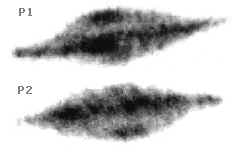
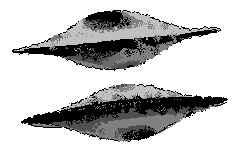
Fig.13
It has been claimed that if the object is real there is no sensible interpretation of the apparently-migrating 'dark spot'. But there are at least two possible and physically sensible interpretations in terms of one or more permanent surface features, as shown in Fig.14.
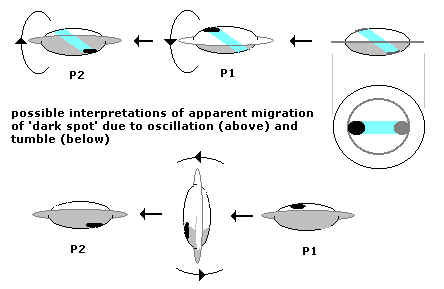
Fig.14
1) In the first interpretation a relatively small inclination relative to the line of sight, either due to a periodic lateral oscillation of the object or to an occasional change of perspective (see Fig.2), causes similar dorsal and ventral features to be alternately concealed and revealed. I don't believe that any realistic assessment of the P1 and P2 images could claim to rule this out.
2) The second interpretation (tumble end-over-end) remains vulnerable to the criticism that no witness described seeing the object invert, although it is true that Capt. Viegas did describe in 1958 how at one point he saw the object "tilt" and reveal more of its underside. This could be interpreted as more naturally consistent with 1) above, as also could Barauna's later recollection that the object was seen to "tip twice" during its erratic passage across the sky. But such statements, and the description of the movements of the object as "abrupt" and "batlike", are at least not inconsistent with the possibility that the object flipped over.
In this connection, Brad Sparks has reported finding evidence of a rotational blurring in the UFO images distinct from lateral blurring due to bulk forward motion. This is a blur that reportedly increases with distance from the centre of the object, suggesting that the camera has almost stopped a rotation or oscillation occurring in the plane of the film. Once again this could be related to the undulatory motion described by witnesses, but a violent oscillation at the rate of 400-800 degrees/sec. inferred by Sparks could also be said to suggest a kind of dynamical instability that might go over into a complete inversion at some point. If so, this rate equivalent to perhaps two complete rotations per second obviously implies the possibility of a 180° inversion in about 0.25 sec.
It is presumably not up to us to declare that a "flying saucer" is unable to suddenly invert - at least, we have no data on this question! But Kentaro Mori has objected that the attitude of the object is not far from the horizontal in any of the four photographs. If the object did invert - at least twice to account for the apparent migration of the 'dark spot' (from the top in P1, to the bottom in P2 & P3, and then back to the top in P4) - isn't it suspicious that none of Barauna's photographs caught it in the act of actually inverting?
To gauge the probability of this if we assume a total period of possible photography of (say) 60 seconds for simplicity, the total time the shutter is open = 4 x 1/125 sec. = approx. 1/30 sec. (not 6 x 1/125 sec. since we cannot legitimately factor in the two shots that missed their subject), and 60/(1/30) is 1800, or: Given that the intrinsic probability of an inversion is a constant, then a naive probability for the shutter being open at any given instant of an inversion-in-progress is about 1/1800.
This figure would then need to be multiplied by a factor proportional to the ratio between the period of the inversion and the shutter speed - i.e., if it took 1/125 sec. to invert then the factor would be 1.0; if it took 1 second the factor would be 125, and so on. The result is then multiplied again by the number of flips. So, even if the flipping process took a full second (a movement that would be clearly visible to the eye), and happened twice, then the probability is 1/7. In other words we would need to have several identical fly-pasts occur before we could say that the probability of Barauna photographing a flip even once could be said to be very high. With the more realistic assumption that a flip takes 0.25 sec., as inferred above, then the probability of capturing the UFO during either of two flips falls to 1/28, and so on.
This is based on a total sighting length of 1 minute. If the total period of possible photography is taken as 2 minutes (a figure arguably more consistent with some evidence, such as the cloud displacements between P1 and P4) then the above odds lengthen to 1/56. On the other hand, the Navy Intelligence study reportedly produced (according to Barauna) a figure of 14 secs. duration for all six shots. From the description Barauna gives of the Navy reconstruction leading to this figure, it should almost certainly be understood as the minimum overall duration for six exposures based on timing Barauna's operation of the manual film-advance mechanism. So taking this as a minimum we would begin with a naive probability for the shutter being open at any given instant of an inversion-in-progress of about 1/420, and the odds would shorten. Even so, for two 0.25-sec. flips in 14 secs the shortest reasonable odds remain almost 7:1 against Barauna's shutter being open at the time.
Clearly we have no reliable information to plug in here and the model is very crude; nevertheless we do get a sense of the fact that it is not very surprising that Barauna failed to catch the object in the act of any rapid flipping that it may or may not have done. A prudent person would bet against him doing so by chance.
However there is still a third possibilility that does not involve flipping: The 'dark spot(s)' may not be a permanent surface feature at all.
Witness testimony describes the object partially shrouded in something resembling a vapour, which is arguably consistent with the blotchy and striated texture of parts of the photo images examined here. If so then the dark spot and other apparent 'shadow' areas of the object might be the object's dark surface partially visible through rifts or thinnings in a sheath of paler vapour.
Capt. Brandao, Navy Intelligence (emphases added):
"He said that, seeing the UAO at naked-eye, his impression was that of a solid body, with ill-defined contours, showing great mobility at high speed, and with a dark colour difficult to define because the object seemed to be enveloped by a substance he compared to soap foam; it seemed to have a small contrail of the same material and was moving without any sound."
Barauna's interview with Joao Martins, 08 March 1958 (emphases added):
"It showed a dark gray color, appearing to be surrounded - mostly in the area ahead of it - by a kind of condensation of a greenish, phosphorescent vapor (or mist)."
It could be argued that a hoaxer invented this detail precisely so that we would have something by which to explain away subtle inconsistencies between the pictures. But why would a hoaxer who paid this much attention to detail make his fakes so oddly 'inconsistent' in the first place?
Looking again at the enlarged and enhanced images - particularly P1 and P2 - with this testimony in mind, it cannot be denied that a good description of their texture would be "frothy". But what the physical significance of this might be is an open question. Also the striation is quite curious, especially in P2. It does not suggest streamline flow over an aerofoil, for example, but seems to cross the image athwart the average right-to-left direction of travel. The angle of obliquity of the striations above the flange can be traced across the face of the image in faint streaks below the flange and is also echoed by the edges of the parallellogram-shaped 'dark spot'. There is no obvious explanation for this internal feature.
However there is at least one other photographic case with a similar feature - the unexplained photograph taken by a government aerial survey camera over Costa Rica on 04 September 1971. In this case the investigators report:
| There appears to be a very interesting obliquely oriented micro- and macro-structural detail on the image of the object itself. [T]he left-hand edge consists of dozens of thin, parallel fingers of light that originate in the "body" of the object and fade out into the background luminance. . . . The right-hand edge possesses a much more regular (smooth) contour than the left but also possesses many very short jagged lines of light, each of which is oriented in the same direction . . . [O]ther details having this same orientation . . . are: (a) the upper and lower edges of the disk . . . (b) a relatively long, thin dark line that originates in the central region . . . and (c) the alignment of the two dark regions near the middle of the disk. We have no clear understanding of the origin or meaning of this oblique orientation effect seen in so many of its surface details. (Haines and Vallée, 1999) |
© Martin Shough 2004
Brandao, Capt. Jose Geraldo, Intelligence Service, Report about the observation of unidentified aerial objects, occurring in the Trindade Island, in the period between 12-5-57 and 1-16-58, Brazilian Navy Ministry, Navy High Command Intelligence Department, 03 March 1958. Compare translations at http://www.nicap.org/barauna_docs.htm and http://www.cufos.org/Trindade_New_Evidence_article.html
Haines, R. and J. Vallée, 'Photo Analysis of an Aerial Disc Over Costa Rica', in: Sturrock, The UFO Enigma, Warner NY 1999, p.197-215. See also Journal of Scientific Exploration: http://www.scientificexploration.org/jse/articles/ufo_reports/haines_aerial/1.html
Mori, Kentaro, The Amazing UFO http://www.geocities.com/airsmither/trind.htm
All image processing by Presto!ImageFolioLE
Thanks to photographer John Dudak http://www.dudak.baka.com/default.html for his handy depth-of-field calculator.